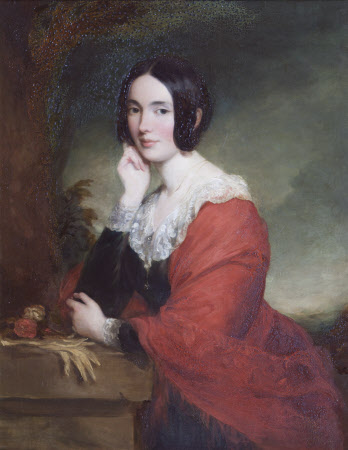Lady Marian Margaret Compton, Viscountess Alford (1817-1888)
Sir Francis Grant PRA (Kilgraston 1803 - Melton Mowbray 1878)
Category
Art / Oil paintings
Date
1841
Materials
Oil on canvas
Measurements
902 x 699 mm (35 ½ x 27 ½ in)
Place of origin
England
Order this imageCollection
Belton House, Lincolnshire
NT 435959
Caption
Lady Marian Alford believed that hand embroidery should be valued as an art form and deserved to be recognised as a skilled profession. These two principles led her, with Princess Christian of Schleswig-Holstein (1846–1923, daughter of Queen Victoria) and Lady Victoria Welby (1837–1912), to establish the School of Art Needlework (later the Royal School of Needlework) in London in 1872. An article in the Art Journal described Alford, its vice president, as ‘the life and soul of the school’. Based above a bonnet shop on Sloane Street, it initially employed 20 women – all ‘reduced gentlewomen’ who needed to earn a living. Within three years the number of employees had grown five-fold and the school moved to new premises in South Kensington. The women were taught a broad range of needlework skills, enabling them to work on commissions, exhibit work, undertake repairs to historic textiles and teach others. In 1886 Alford published her influential historical and technical study Needlework as Art, which observed that ‘… millions have enjoyed the art of the needle for thousands of years, and it will continue to be a solace and a delight as long as the world lasts, for, like all art, it gives the ever new joy of creation’. Alford was also a keen patron of artists including Elisabet Ney (1833–1907), the first woman to study sculpture at Munich Academy of Art (Alford exchanged a piece of her celebrated embroidery for two of Ney’s commissioned works). Alford had a long, close relationship with sculptor Harriet Hosmer – Elizabeth Barrett Browning described Alford kneeling before the artist and placing a heart-shaped ruby and diamond ring on her finger, to Hosmer’s delight. Hosmer was commissioned to create the ambitious Siren fountain for Alford’s Knightsbridge home, Alford House, which was built in 1869–71 by the architect Sir Matthew Digby Wyatt (1820–77). Alford designed the external ornamental ironwork and much of the interior decoration; an 1869 design for a curtain in crimson and gold, with sunflowers and thistles, is at Belton House, Lincolnshire. A beautiful set of monogrammed curtains, later adapted into bed hangings, may also have been created for Alford House.
Summary
Oil painting on canvas, Lady Marian Margaret Compton, Viscountess Alford (1817-1888) by Sir Francis Grant PRA (Kilgraston 1803 - Melton Mowbray 1878),1841. A three-quarter-length portrait, standing, turned to the left, gazing at the spectator, leaning on a stone pedestal on the left, her left hand by her chin and the right hand on the pedestal on which her gloves are lying. Her dark brown hair is looped below her ears and she is wearing a dark blue dress with white lace collar and cuffs. a red shawl or wrap is draped over her right shoulder. A tree trunk on the left leaves and branches above her head and distant view of landscape and sky to the right.
Provenance
Purchased with a grant from the National Heritage Memorial Fund (NHMF) from Edward John Peregrine Cust, 7th Baron Brownlow, C. St J. (b.1936) in 1984
Credit line
Belton House, The Brownlow Collection (acquired with the help of the National Heritage Memorial Fund by the National Trust in 1984)
Makers and roles
Sir Francis Grant PRA (Kilgraston 1803 - Melton Mowbray 1878), publisher
References
Conroy, Rachel, Women Artists and Designers at the National Trust, 2025, pp. 124-127

